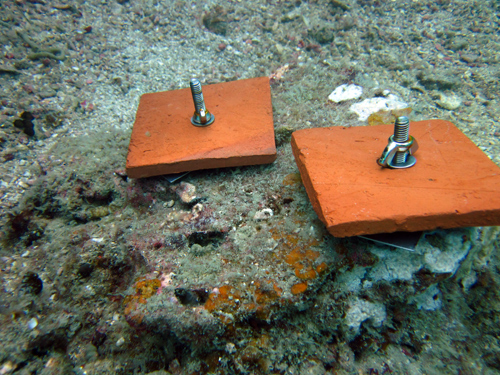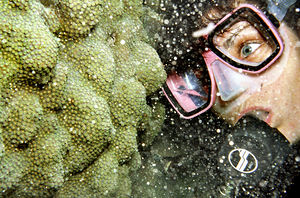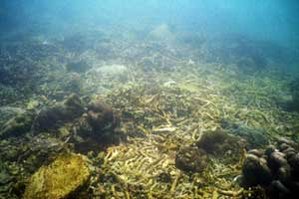SettlementPlates

Settlement Plates
What are settlement plates?
Settlements plates are man-made scientific devices that are designed to simulate the natural strata that corals settle on. Corals settle on the plates during a given time period, and the plates are removed and analyzed in a lab. The amount of coral larvae (coral spat) on each settlement plate allows scientists to learn about the rate of coral recruitment and, therefore, the health of the reef. [2] Scientists often use settlement plates to determine the timing of coral spawning events, which can allow scientists to study the reproductive processes of the reef.
Because settlement plates are used to measure the recruitment of coral larvae, settlement plates are only found in coral reefs or places where corals are able to live. The position of settlement plates on the reef are very important to consider when comparing results from settlement plates. Flow and coral abundance varies greatly throughout the reef, so it would not be accurate to compare a settlement plate that is attached to a reef at 10 meters deep to a settlement plate that is attached at 5 meters deep.
Different types of settlement plates include ceramic tiles, petri dishes, glass, dead branching coral, and slices of stony coral. Ceramic tiles are the best option because they are relatively inexpensive, easy to replicate, easy to analyze in a lab under a dissection microscope, and are similar to the calcium carbonate strata that corals naturally settle on. [2] Orientation of the settlement plates does not have a large effect of the amount of coral spat per tile, but the most efficient implementation is a horizontal orientation with multiple stacked tiles that create a gap habitat for larvae to settle into. [3]
What do settlement plates measure?

Settlement plates measure coral recruitment, which is the process of coral planulae settling on a substrate and commencing to grow their calcium carbonate shell. The health of a coral reef is closely linked to the amount of coral recruitment; the more recruitment, the healthier the reef, and vice-versa. [3] Scientists still do not know very much about the reproductive processes of corals and how a coral planulae ends up where it does. Settlement plates are essential to the study of coral recruitment and the health and growth of a reef.
How are settlement plates used?
Settlement plates are an important scientific tool for assessing the recruitment rates of coral planulae to the reef. They function as a substrate for coral planulae to attach, mimicing ideal conditions. When attaching settlement plates for an experiment it is extremely important that depth and location on the reef are taken into consideration. In an ideal experiment the plates are set either at a consistent depth throughout the reef or in one of the 3 main physical structures of the reef: upper fore reef, lower fore reef, back reef (lagoon).[2]
In order to avoid settlement plates causing damage to healthy reefs they should be firmly attached onto existing dead reef using wire mesh or steel bolts or on heavy, fixed, objects like concrete blocks. To attach steel bolts a hole must be drilled through the settlement plate and the substrate, typically an overhang or dead coral head, and secured with either two wing nuts or the bolt should be screwed in or cemented in. The steel bolts provide a strong, rust-resistant, binding that can survive weathering and human or animal interaction.[2]
Settlement plate experiments rely heavily on timing. Reefs are sensitive ecosystems and little is known about coral reproduction and timing. Plates are installed in a manner that minimizes tampering with healthy reef parts and time spent monitoring the plates. By infrequently checking plates it provides a general recruitment rate and limits financial costs in travel for the experiment, as most reefs are not easily accessible. Plates should be placed either directly before known spawning events, if they're well documented by species/region, or placed and left for a year to get a more general idea of the recruitment rate and survivorship. After allowing recruitment to take place the plates are carefully removed from the substrate and bleached. The bleaching kills the organisms on the plate and turns the microscopic corals white and freezes them. After drying the plate can be put underneath a dissection microscope and the recruitment can be quantified from there based on the type of study. Another novel use that has come from evaluating the plates with a dissection microscope has been identifying other sessile forms of larvae that are found on the plate, possible microscopic predators that feed on coral planulae, and evaluating how the coral compete for space in their planulae stage.
The best characteristic about settlement plates is that they can be easily removed from coral reefs without causing damage to healthy corals or intruding on the environment. Small unfinished ceramic tiles provide a great mimic to the natural substrate that coral planulae encounter while drifting through in the current. These ceramic tiles have been found to produce equivalent yields to, traditionally more damaging, dead coral plates. [3]

Problems with Settlement Plates [2]
Using settlements plates in coral research is an extremely popular and efficient means of investigation. There are however a few problems associated with this research technique that, with careful planning, researchers must remain aware of. While settlement plates, especially unfinished ceramic tiles, provide an excellent mimic of the natural substate found in coral reefs they are perfect replicas. The settlement plates are clean surfaces that do not substitute perfectly for a reef surface. In a natural setting even a coral planulae that reaches the reef may not find the type surface that it needs and die. Just like a juvenile animal needs certain characteristics in a nursery, so do coral planulae. This means that some juvenile coral polyps might not adhere well, possibly causing bias in the data. The results gained from the recruitment might only be representing the more hardy, pioneering species. Often plates only 5 meters apart can show drastic recruitment differences caused by light exposure, plate orientation, or subtle depth change.
While settlement plates are generally considered a relatively inexpensive experimental technique, the type of settlement plate along with bolts, and installation equipment can get expensive. While it might seem practical to use a cheaper plate type (i.e. petri dish, glass plate, cinder block) these materials will each produce varied results and are only really comparable to other studies using that specific plate type. Other plate types can be more hazardous to the environment: breaking glass, plastics, carving plates out of dead coral. In the past actual dead coral were taken and used to mimic a 3D recruitment surface. While this in theory seems like a good idea to mimic the natural surface it keeps dying reefs from having a chance at recapturing their zooxanthellae and makes quantifying recruitment very difficult due to 3D coral plates being difficult to manipulate under dissection microscopes.
Examples of settlement plates being implemented
St. John, USVI

In St. John, USVI, settlement plates have been implemented to study coral recruitment patterns around the island. Settlement plates were deployed at 10 different sites along 10 kilometers of shore. These plates were replaced every 6 months for over 2 years. Temperature and flow were recorded at each site over the 2 year period. Results showed that more coral recruitment was occurring on the western side of the island (approx. 4 coral spat per tile) than the eastern side of the island (approx. 1 coral spat per tile). This difference in recruitment was attributed to patch depletion and downstream filtering of the coral larvae. Temperature and flow had a limited impact on the coral recruitment patterns. [7]
Phi Phi Islands

In the Phi Phi Islands of Thailand, many coral reefs suffered damage from a tsunami that hit the area in 2004. Approx. 13% of coral reefs were severely damaged around the islands that were effected. Researchers deployed settlement plates around the Phi Phi islands 1 year and 3 years after the tsunami to measure the recruitment differences between damaged and undamaged reefs. The settlement plates were deployed for 4 months. The results showed that there was no difference between the recruitment rates of undamaged and damaged reefs following the 2004 tsunami. [9]
Peer Comments
optional: include an image of stacked settlement plates from the first subheading
subheading 2: soother transition between sentences 3 and 4: '...coral planulae ends up where it does, but settlement plates are essential...'
subheading 3: spelling of mimicking
Notes
- ↑ "Eco Koh Tao | Eco Diving Courses, Gap Year Opportunities and Eco Internships - Koh Tao, Thailand." Eco Koh Tao | Eco Diving Courses, Gap Year Opportunities and Eco Internships - Koh Tao, Thailand. N.p., n.d. Web. 26 Feb. 2013.
- ↑ 2.0 2.1 2.2 2.3 2.4 Harriott, Vicki J., and David A. Fisk. "A comparison of settlement plate types for experiments on the recruitment of scleractinian corals." Marine Ecology Progress Series. 37. (1987): 201-208. Print.
- ↑ 3.0 3.1 3.2 Salinas-de-Leon, Pelayo, et al. "Scleractinian Settlement Patterns to Natural Cleared Reef Substrata and Artificial Settlement Panels on an Indonesian Coral Reef." Estuarine, Coastal and Shelf Science 93.1 (2011): 80-5. GeoRef. Web. 25 Feb. 2013.
- ↑ "Coral Reproduction." NOAA's Coral Reef Conservation Program:. N.p., n.d. Web. 28 Feb. 2013.
- ↑ "Late Summer Full Moons to Cue Spawning on Keys Coral Reefs | NewmanPR." NewmanPR. N.p., n.d. Web. 17 Apr. 2013.
- ↑ "Spatio-temporal variability of coral recruitment on shallow reefs in St. John, US Virgin Islands." Journal of Experimental Marine Biology and Ecology, Volume 397, Issue 2, 15 February 2011, Pages 220-229
- ↑ Green, Daniel H., Edmunds, Peter J.. "Spatio-temporal variability of coral recruitment on shallow reefs in St. John, US Virgin Islands." Journal of Experimental Marine Biology and Ecology, Volume 397, Issue 2, 15 February 2011, Pages 220-229
- ↑ "Threats to Coral Reefs." Threats to Coral Reefs. N.p., n.d. Web. 17 Apr. 2013.
- ↑ Phongsuwan, N., C. Richter, and Y. Sawall. "Coral recruitment and recovery after the 2004 Tsunami around the Phi Phi Islands (Krabi Province) and Phuket, Andaman Sea, Thailand." Helgoland Marine Research 64.4 (2010): 357+. Academic OneFile. Web. 25 Feb. 2013.